The shelves were next and they were produced in exactly the same way as the top, two boards jointed and glued together.
Then I noticed a huge problem - I only had enough sapele wood for the two bottom shelves. I had miscalculated on the amount of stock I needed. Fortunately I had some baltic birch plywood 18mm thick (3/4" nominal)
and I have a heap of veneers - some are rolls of sapele. So I set about veneering the top face of some of the birch ply. Normally I would veneer both sides of a substrate to ensure flatness but this is 18mm thick and won't bend appreciably.
I don't currently own any vacuum veneering equipment yet and normally use the veneer pressing method. Essentially this involves using some cold press veneer adhesive, gluing the veneer to the ply substrate and then applying a plastic covered caul over the top of the veneer with a large weight and a few clamps holding it down while it cures.
This works fine for flat even shaped panels such as this.
Preparing the veneer
The first thing to do was to cross-cut the veneer to approximate length. I use a proper veneer saw with a craft self healing mat as a backer. I also use a safety rule as a straight edge. No point in risking your fingers whilst pressing down on a regular ruler.
 |
| Self healing cutting mat and a safety ruler |
 |
| The Pax veneer saw - Sheffield England made. |
When I had cut up enough lengths of veneer I needed to get it's moisture content up to stop it from bending or potato chipping. There are a few veneer conditioners that are available in the US but I can't get any of them or anything like it in England - not sure why nobody makes it over in Europe as it looks great. Anyway I just use regular tap water to spray on both sides of the veneer.
 |
| Liberally spraying with water |
I first placed a sheet of ply onto the bench and a layer of paper shop rag. Then each sheet of moistened veneer is placed in alternate layers with shop rag in between making up a sandwich of veneer and shop rags.
 |
| The sandwich is left overnight |
Veneer glue-up.
The next day I came back and had a look at the now flattened veneers. All was good. I then used a straight edge to cut a straight line down one edge of the veneer. I also did another piece and butted them together. Sometimes you have to have another go to ensure that you get it straight.
 |
| Cutting a straight edge |
Then I applied veneer tape to the upper surfaces of each leaf to hold it together. Glue was spread on both the veneer and the baltic birch ply substrate. The veneer glue I use is Titebond cold press veneer adhesive. I apply it with an ink roller.
The veneer was then applied to the substrate and pressed down with a veneer roller.
 |
Pressing down from the centre to the edges with
a veneer roller. |
The plastic faced ply cauls were brought back into use again and used to clamp the veneer/ply together and left to cure overnight.
 |
| Stage weights and extra clamps were used |
Cutting the boards to size.
I had already cut the plywood substrate to size in a previous operation. When the newly veneered board was taken out of the press all that was left to do was to cut the excess from the board.
 |
Excess cut off with a veneer saw.
You have to take care in this process as you can chip the
edges and show face of the veneer unless you are careful. |
The board was turned over and the veneer tape was removed. The boards were then cleaned up with a random orbit sander taking care not to burn through.
 |
A finished board. I used 180 to 220 grit on a random
orbit sander to clean up. |
Rabbetting (rebating) the edges.
Each board then had a 4mm (5/32") deep rabbet applied to the underside to ensure that the top of each shelf came slightly below the shelf support rails. We had decided in the early stages of the design that this slight lip would prevent items such as pencils rolling off the shelves.
 |
| Rabbet was applied by hand with a Record #778 Rebate/Rabbet plane |
So I dodged a bullet there and the moral of the tale is always ensure you have enough stock to complete the project or learn how to veneer.



















































